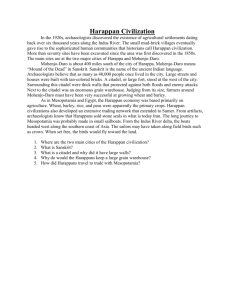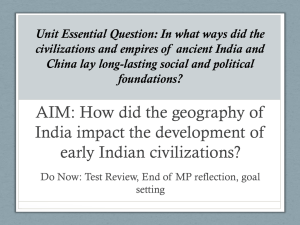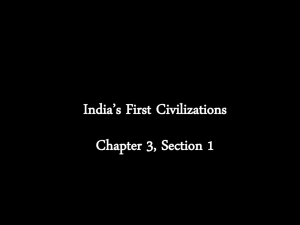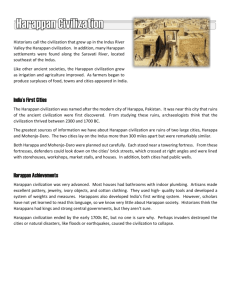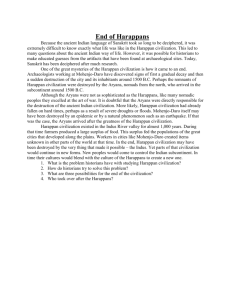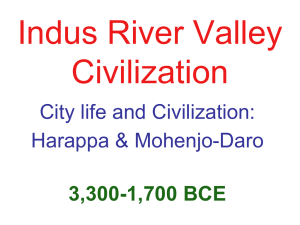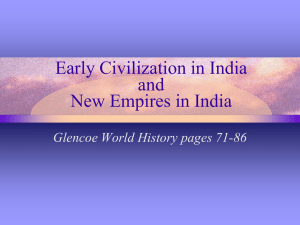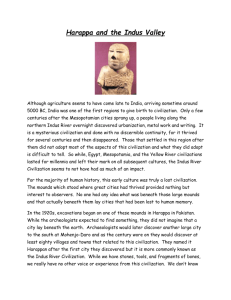Early Indian Civilization
advertisement
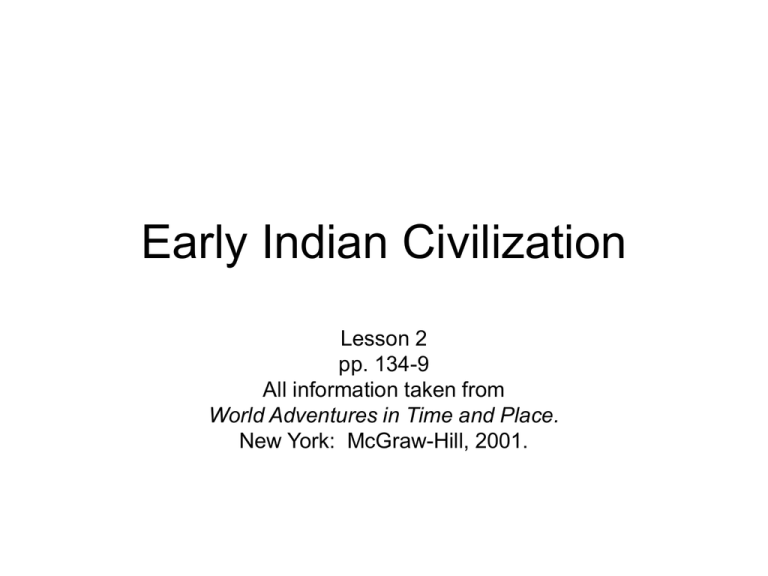
Early Indian Civilization Lesson 2 pp. 134-9 All information taken from World Adventures in Time and Place. New York: McGraw-Hill, 2001. Vocabulary • • • • • Citadel Migrate Harappa Mohenjo-Daro Sanskrit READ ALOUD • In 1921 archaeologists gathered around a huge dirt mound on the southern plains of the Indus Valley. They knew remains of the past lay hidden beneath the mound. Earlier visitors had found artifacts there. But how old were the remains? What would they reveal about how Indian people lived long ago? • As the archaeologists dug down, the ruins of a great city began to appear. A new understanding about India’s ancient past had begun. The Big Picture • Location – 1000 miles from Iraq (Mesopotamia) – Civilizations still traded 4000 years ago • Knowledge – Least is known about Indus River Valley – Archeologists can’t read the writing – Few artifacts and remains have been found A Civilization in the Indus Valley • Harappa – In the northern part of Indus Valley – Ruins named after an Indian god – What people called themselves when they lived is unknown – It lasted from 2500 B.C. to 1600 B.C. • Mohenjo-Daro – “Mound of the Dead” (Sanskrit) – Found a year later – Exactly like Harappa – 400 mile south A City Along the Indus Mohenjo-Daro (p. 135) • Population – 40,000 • Dozens of crisscrossing streets – Large – paved with tan bricks – Smaller – narrower; unpaved • Brick houses – – – – Small One-room buildings Multi-sotries Airy courtyards/balconies • West end – citadel – Surrounded by thick walls protecting from flood and attacks – Huge grain warehouse for barely and wheat Life in Mohenjo-Daro (p. 136) • Challenge for archaeologists because they can’t read language but can look at structure of city • City Planning – Exact measuring of buildings – Same sized bricks – Dug wells located throughout city – Sewers with manholes Drawing conclusions • Historians think – Mohenjo-Daro had a “strong central government” since Harappa had same layout – Citadel exhibited a building with large pillars that perhaps served as city hall that “overlooked the city”(p. 137). - bath may have been used for religious practices Working in Mohenjo-Daro • Workers were highly skilled – Builders – Engineer – Craftworkers • Stone carvers – Figures in small squares of stone – May be used to mark belongings • Potters – Water jars – Cooking bowls – containers • Metalworkers – Copper fish hooks – Razors – Bronze statue • Weavers - First time in history - wove cotton cloth • Farmers – Produced surplus – Stored in warehouse – Grain collected for taxes – Possibly payment to government workers Harappan Trade • • • • Traded near and far Sold stone seals to “Iran” Bought blue stones from “Afghanistan” Beads/necklaces made on stones from India • Above were traded in Mesopotamia • Trip made in sail boats • Used field birds to locate land Newcomers • Mohenjo-Daro deserted around 1600 B.C. – Earthquake changed course of river – No water; no civilization – Earthquake could have caused destructive flood • 1500 B.C.invaded by Aryans – – – – – – – Originally from central Asia Herded cattle and sheep on horseback Came from Hindu Kush Mountains Means “noble ones” in Sanskrit Brought their language Brought new ideas Brought new religion Why It Matters Harappan civilization lasted 1000 years Farmers produced a surplus food Population fed Civilization grew Workers produced cotton cloth, stone seals and drainage systems for all of civilization Destroyed by waters that also produced it. Aryans came blending cultures Main Ideas • Little is known about the Harappan civilization because its writing system has not yet been figured out. • The city of Mohenjo-Daro included many brick buildings and a huge citadel. The city also had a sewer system more advanced than any other of its time. • The orderly layout of the city and its large grain warehouse suggest that Mohenjo-Daro wa ruled by a strong local government. • Harappan merchants traded goods in many places, some of which were as far away as Mesopotamia. • In about 1500 B.C. people called Aryans migrated to the Indian sub-continent. They brought new ideas to the region. Think About It • Why is the ancient Indus Valley civilization called Harappan civilization? • What have historians learned about Harappan civilization from written sources? What have they learned from building remains in cities like MohenjoDaro? Focus • What do we know about the early culture of Mohenjo-Daro? Thinking Skill • Based on the information in thi leson, what conclusions can you make about the people who lived in Mohenjo-Daro? What evidence supports your opinions? Geography • Draw the map showing the migration of the Aryans and trade routes

